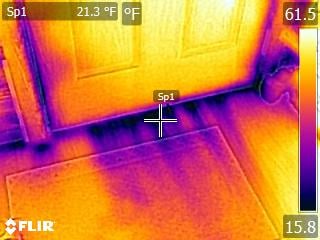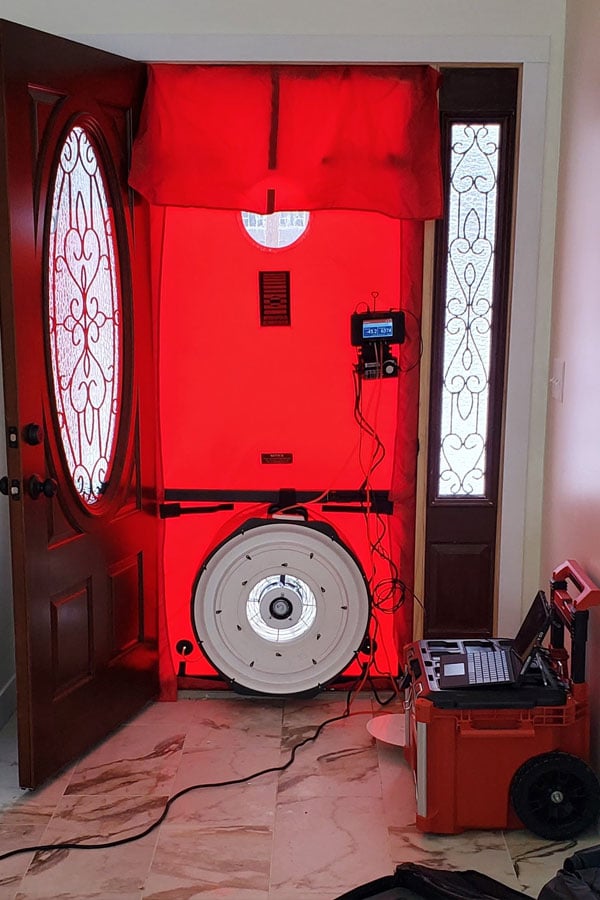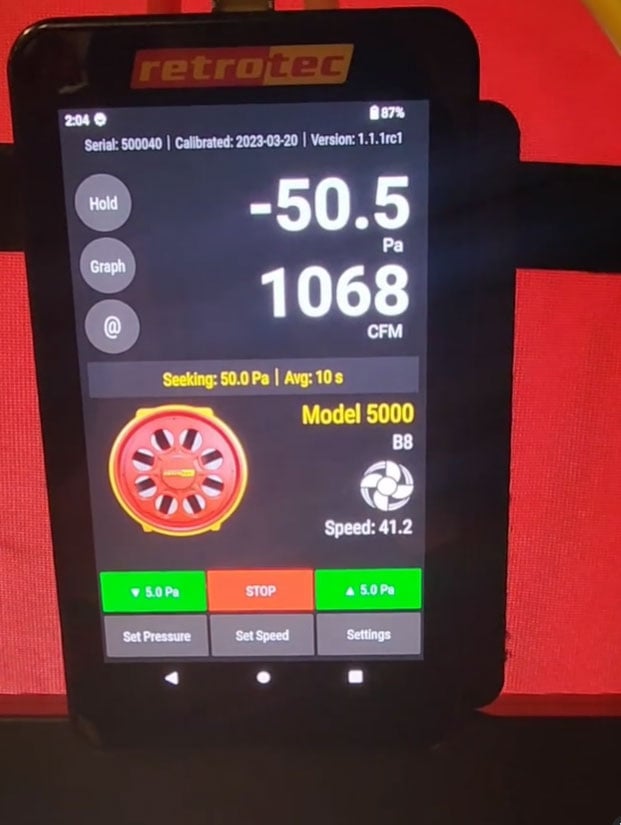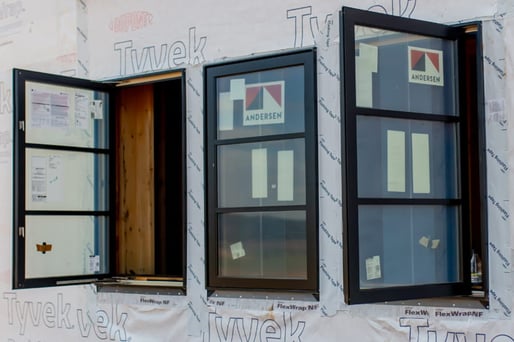By Randy Williams
What is a blower door test?

What is a blower door test?
A blower door test is a test to confirm the continuity and integrity of a structure’s air barrier.
This leads to another question: What is an air barrier? An air barrier is the part or parts of a structure that creates the separation between inside and out. An air barrier is typically several different building products assembled in a way that keeps the outside air outside and the inside air in. A properly designed air barrier needs to be defined. Is it the wall and roof sheathing? Maybe it’s the closed cell spray foam installed inside the wall cavity, or it could be the interior finished drywall. It’s also going to include windows and doors. It can be all these products and more.
Most importantly, the air barrier needs to be continuous. No holes, no cracks, no breaks … continuous. Think of the children’s song, “the foot bone is connected to the leg bone, the leg bone is connected to the knee bone ... ” Every part of the air barrier needs to be connected and continuous.
Why do we care? Why is blower door testing important?

How does a blower door work?

What is a Pascal?

How to interpret blower door test results
Once we run a test and determine the CFM rate of leakage at the blower door-induced pressure of 50 Pascals, we can then manipulate that information to denote how good or bad the leakage is for the home. The most common way to show leakage is air changes per hour at 50 Pascals, abbreviated as ACH50. For this metric, we need to know the volume of the structure. Let’s use an example house that is 25’ wide by 40’ long by 10’ high. This home has a volume of 10,000 cubic feet. Performing a blower door test on this structure produced a result of 167 CFM. To calculate the ACH50 number, we use the formula (CFM50 x 60 minutes)/volume. We need to change the cubic feet per minute to cubic feet per hour, this is the reason we multiply by 60. In our example, (167 CFM x 60 minute per hour)/10,000 ft³=1.0002. We can round that number to 1 ACH50.
The next question, is 1 ACH50 good? The answer is: maybe. If you are simply looking to pass the code required blower door test (more on the codes for blower door testing in a minute), then yes, 1 ACH50 is great. But if you are looking to receive a Passive House certification, the answer is no. You have a little more air sealing that needs to be completed since Passive House Certification requires a blower door score of .6 ACH50 or less.
Blower door codes
Blower door testing has been code-required in residential construction since the 2012 edition of the International Residential Code (IRC). The requirements of the code are found in Chapter 11, Energy Efficiency. Not a lot has changed in the code requirements between today and 2012, air tightness requirements are based on which climate zone you are located in. The requirements are:
- Climate Zones 0-2: 5.0 ACH50 or less
- Climate Zones 3-8: 3.0 ACH50 or less
These codes may vary depending on local adoption or amendments to the code requirements. Always check with your local authority for the air tightness requirements of your location.
Other uses for blower doors
As I said at the beginning of this story, a blower door is used to confirm the continuity and integrity of the air barrier, but a blower door has other uses. I often use my blower door to identify problems with the air barrier. When I combine a blower door and thermal imaging camera, I can often “see” holes in the air barrier.
Sometimes it’s a good idea to perform blower door testing while a project is under construction. This is called mid-construction testing. This type of testing is usually performed when specific air tightness requirements are needed. For instance, a home’s heating, cooling, and ventilation equipment might be sized based on a specific air tightness goal. Missing those goals might affect the performance of the equipment and cause comfort issues. Testing during construction can ensure tightness goals are on track.
Blower door testing can also be part of an energy audit or building investigation. When a homeowner’s expectations for the cost of heating or cooling their home aren’t met, or there is a specific problem with the home, usually some sort of water issue, a blower door test is one of the tools to discover the source of these problems.
A blower door can also be combined with another piece of testing equipment called duct tightness testing. This equipment tests the tightness of forced air heating and cooling ductwork. When used with a blower door, the amount of air leaking out of or into ductwork, when the ductwork is outside the building envelope, can be determined.
Is blower door testing equipment worth it?
If you’re interested in learning how to operate a blower door or purchasing your own equipment, there are two major manufacturers to be aware of in North America. The Energy Conservatory makes the Minneapolis Blower Door™ System and Retrotec makes a variety of blower door systems. Both manufacturers offer online training for their equipment, but the best way to learn how to use a blower door is with hands-on training. Both the Building Performance Institute (BPI) and RESNET (Residential Energy Services Network) offer training that includes instruction on how to operate a blower door. The education provided by these two organizations goes way beyond just blower door testing, but the lessons learned are valuable education for the construction industry.
Blower door test equipment, as you might imagine, isn’t cheap. A full test kit by either manufacturer will set you back around $4,000. Add in a thermal imaging camera, a second digital manometer (used for advanced building diagnostic testing), and the training to learn how to operate the equipment, and you’ll be nearing the $10,000 mark.
Hiring someone to perform testing is an option, if you don’t have the desire to purchase or learn how to perform testing. Both RESNET and BPI have listings on their websites on certified individuals and companies who perform blower door testing. You can also contact local energy providers, such as your local electricity or gas provider. Often, they partner with local energy auditors for their services.
It’s becoming a more common practice to test the air tightness of our homes. With building codes requiring testing, in most areas of the country, and homeowners becoming increasingly aware of the benefits of improved airtightness, the blower door test has become an integral part of the construction industry. My advice to homeowners is to ask for testing and have a basic understanding of a good or bad test result — see the blower door codes section. And my advice to contractors is to set air tightness goals for your projects and try to improve with every new build. Blower door testing isn’t rocket science, it’s building science!
*New air sealing fact sheet (energystar.gov)
Up next

Window performance
How to pick out windows for your climate

Window performance
Understanding window performance
Meet Randy
Randy Williams started his construction career in the mid-1990s installing electrical, plumbing, and HVAC systems with his brother. In the early 2000s, his family branched into building and renovating homes. By 2005, Randy was working full time as a general contractor. He furthered his education in 2009 becoming an energy auditor. Today, Randy works with other contractors, homeowners, and utilities performing energy audits, building diagnostics, energy design, and code compliant testing, and assisting in the design of energy-efficient homes. He is also a contributing author to several trade publications and occasionally teaches home diagnostic testing and building science topics at different trade shows and training events.


